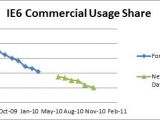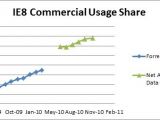Just as it was the case for Windows, upgrading from Internet Explorer 6 to Internet Explorer 9 will be a much smoother process if customers use IE8 as a stepping stone, much in the same manner as moving from Windows XP to Windows 7 was easier for those that also embraced Windows Vista. Internet Explorer 6 usage has been dwindling for the past years, but fact is that this browser version is extremely resilient, an aspect which was constantly blamed on enterprise customers.
It turns out that this should not be the case, at least considering the IE6 usage data for the past half a year.
“In the last six months, IE6 usage is now declining faster among enterprises than it is among worldwide consumers. We believe this reflects how organizations are recognizing the need to migrate to a modern browser,” revealed Roger Capriotti, Director, Internet Explorer Product Marketing.
According to statistics shared by the Redmond company, IE6 usage share as reported by Net Applications, dropped to as little as 14.55% in November, 2010.
But it appears that corporate customers are moving faster than end users when it comes down to dumping IE6.
Capriotti underlined that commercial usage of IE6 is actually just 10.3%, and that more and more companies are opting to upgrade to Internet Explorer 8.
“At the same time, IE8 commercial share has surged over the past several months to 34.1% - over three times the commercial usage share of IE6,” he stated.
“Overall, IE8 usage worldwide grew 0.74% in month of November according to Net Applications, while IE6 worldwide recorded its biggest drop in share in several months – dropping 1.38% share.
“Much of IE6 usage share remains in China where IE6 represents 45.2% of browser usage – though it does continue to drop there too from 50.5% in August of this year.”
Microsoft has matched the statistics from Net Applications with data shared by Forrester.
Both companies in fact managed to come to the same conclusion, that IE6 is being dumped in favor of Internet Explorer 8.
“The rate of IE6 share loss from Forrester and Net Applications are on par: Forrester showed an average of 1.8% loss in IE6 share per month versus 1.5% per month from Net Applications. Forrester showed an average of 1.3% increase in IE8 share per month, compared to 0.9% per month from Net Applications,” Capriotti stated.
Of course, as always, small and medium sized organizations are the first to make the jump to new technologies, especially considering that they have a higher level of flexibility in relation to their IT infrastructure compared to enterprises.
Still, Microsoft emphasized that it is seeing the same trend even with the largest enterprises sporting more than 50,000 seats.
At the same time, while some companies are still sticking with XP , they are also upgrading to IE7 or IE8, with less than 20% of XP machines still running IE6.
“The wholesale migration of IE6 to IE8 is encouraging. It reflects on the strong business value that IE8 provides over IE6,” Capriotti added.
“It shows that enterprises are upgrading to a current browser platform for their ongoing or future Windows 7 deployments.
“It means that we have a growing base of enterprises that will eventually be able to migrate to IE9 with relative ease.
“Most importantly, this progress indicates that many IT organizations have been able to successfully mitigate IE6 application dependencies and chose to move towards the benefits of a modern browser.”
Internet Explorer 9 (IE9) Beta is available for download here.
Internet Explorer 9 (IE9) Platform Preview 7 (PP7) is available for download here.

 14 DAY TRIAL //
14 DAY TRIAL // 

